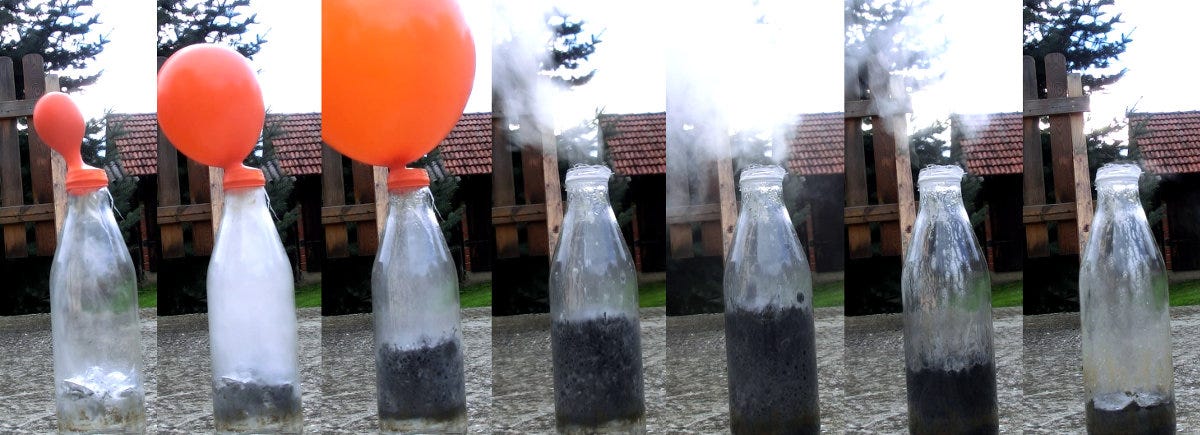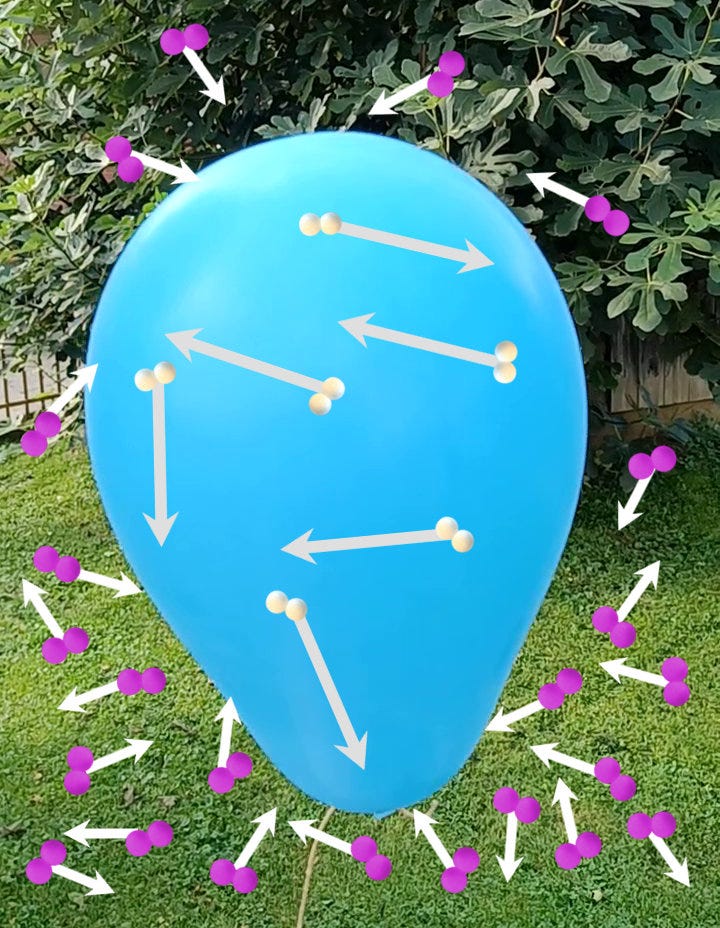In the beginning, the Universe created (mostly) hydrogen. And the Universe was without form, void, and dark. And the Universe moved to create light; and there was light from the first stars fueled by hydrogen.
Hydrogen is the most abundant element in the universe, but on Earth it exists almost exclusively trapped in molecules. It is everywhere around you and inside you, including the water H₂O molecule, which consists of one oxygen and two hydrogen atoms. If released as a pure hydrogen, it forms a hydrogen gas made of H₂ molecules. This is also the lightest molecule possible, and the Earth’s gravity is too weak to prevent H₂ from being pushed into space by collisions between molecules. This also means that a balloon filled with hydrogen gas will fly into the sky.
The current trend of abandoning fossil fuels makes hydrogen the fuel of the future. We are bombarded by wishful thinking of using batteries to power the world, but the simple truth is that any energy intensive activity, from trucks to factories, needs a power source with higher energy density (energy stored within a given volume). The key reaction that makes hydrogen so attractive is very simple – hydrogen and oxygen gas, when ignited, combine into water molecules. The reaction releases so much energy that rockets can use it to lift heavy weight into orbit. The current Artemis 1 mission to the Moon is based on the RS-25 engine that was used already on Space Shuttle missions. Four such engines are supplied with liquid hydrogen (at -253°C) and liquid oxygen (at -183°C), which then produce controlled explosions that combined can push more than 2,000 tones into the sky. In machines like cars or spacecrafts, the hydrogen-oxygen reaction runs within devices called fuel cells, which produce electricity and heat.
As you can see, playing with hydrogen requires very serious safety measures. This might scare you away from making the following experiments, but if you are serious about the safety measures, this should be fun and exciting activity. The advice is the same as in the previous fire in the bottle experiment. First and the most important advice is DO NOT do this experiment if you personally do not feel comfortable about it. If fire is something that makes you highly uncomfortable, then you might not react calmly if something happens that requires your safety reaction. Second, even if you have done this experiment countless times, and you are quite relaxed about it, do not skip the safety measures.

The first step is to discuss the atomic nature of the reactions we plan to make. Introduce the concept of atoms to kids when they are still small and then revisit it in various situations. Slowly, they will grasp the concept. Here we need two H₂ and one O₂ molecule in the beginning. Under room temperature, these molecules collide too slowly with each other to start a transformation. But when we bring a flame or a spark, we introduce fast molecules into this gas mixture. Fast collisions overcome the strength of chemical bonds in H₂ and O₂, which results in a reconfiguration of atoms into H₂O molecules. This process produces fast H₂O molecules that collide with surrounding gas. This chain of collisions and chemical reactions spreads so fast that we experience it as an explosion. Under ordinary air pressure, the reaction reaches about 1,700°C, while under pressure in a rocket engine it goes up to about 3,500°C.
The next step is producing enough hydrogen at home to fill a balloon. Chemistry helps us here again. All we need to do is to dip a chunk of aluminum foil into hydrochloric acid. However, you must be careful here because this reaction can turn nasty very quickly.
Hydrochloric acid HCl is a compound made of hydrogen and chlorine dissolved in water. It has a diverse list of applications, and it naturally exists in your stomach where it is known as a gastric acid or stomach acid. You can buy it in stores in the section with cleaning products. Even though it comes in lower concentrations, you should handle it with protective gloves, goggles, and water at hand to wash it away if it gets onto your skin or clothes.

The problem with the reaction of aluminum with hydrochloric acid is that it releases lots of heat (so-called exothermic reaction). For example, when I used the acid concentration of about 10% or more, it started to boil after I dropped aluminum foil into it. Boiling releases steam mixed with acid, which makes it toxic. The glass bottle might also crack and spill the acid (therefore, do not cool the bottle as the glass will not be able to sustain both the hot and the cold and it will break).

In the reaction, aluminum binds with three chlorine atoms to produce aluminum chloride AlCl₃, while the hydrogen exits as H₂ gas. Interestingly, the reaction does not start immediately. This is due to a layer of aluminum oxide on the surface of aluminum foil. This layer protects us from aluminum reacting with our skin or whatever it touches. The acid first needs to remove this layer, and this takes some time, depending on the acid concentration.

My suggestion for producing pure hydrogen is to use a less dramatic and slower process:
Take a sheet of aluminum foil (30-40cm long), fold it several times and then cut it into small chunks. Go outside and do the following steps using the safety measures described above!
Put aluminum chunks into a glass bottle and add hydrochloric acid (about 300 mL) at concentration of 5% or less. If you use more concentrated acid, add extra water to reduce the concentration.
Put a balloon over the bottle top. Make sure that the bottle neck is dry because if the balloon does not make a good enough grip with the glass neck, the gas will leak out or the balloon will slide off.
Wait for the reaction to start producing hydrogen. Depending on the acid concentration, filling the balloon can take an hour or more.
Stir the bottle content whenever you notice that only the upper part of the liquid is warm. The goal is to avoid temperatures that would boil the liquid and fill the balloon with fumes that condense within the balloon and make it heavy. Remove the balloon when you think it got big enough.
With this approach only hydrogen accumulates in the balloon, which will make it fly. Attach a string to it to prevent it from flying away.
To avoid boiling you might need to repeat the experiment a few times until you find the optimal combination of the acid concentration and volume, and the size of aluminum sheet. Be careful - even if the balloon does not fly, it is full of hydrogen that can explode if ignited.

Let’s quickly explain why the balloon flies. The story is the same as for swimming in water, except that here the Earth’s atmosphere is a big ocean of gas. The explanation has two components:
The air around the balloon is compressed by all the air above it. The air molecules fly fast and collide with each other to resist further compression. But the lower part of the balloon is in the air that is slightly more compressed than at the upper part because of the extra weight of the air between these two slightly different altitudes. This means that the lower part of the balloon experiences more collisions that the upper part where there is a slight lower number of molecules (because of a slightly lower compression). So, the balloon experiences a net force upward called buoyancy. Now, we need the second step.
If the space taken by the balloon is filled by air (i.e., there is no balloon), we have just an ordinary atmosphere in equilibrium where the weight of this air is equal to its buoyancy. But if the balloon is filled with something that is less heavy than the air of the same volume, which means less dense, the buoyancy will be larger than the balloon weight and the balloon will be pushed upward. And how do we achieve this with hydrogen? Two things. First, the H₂ molecule is about 14 times less heavy than the average air molecule. And second, at the same temperature as the surrounding air, the hydrogen molecules are much faster, which enables them to inflate the balloon to volumes larger than the same number of air molecules would do. The average air’s molecular speed at room temperature is about 500 m/s (about 1,800 km/h), while the hydrogen molecules have 2,000 m/s (about 7,200 km/h).

There are other ways how we make balloons fly: using helium gas, or warm air (where we exploit higher speed of molecules in warmer than colder air). And this is not just a silly game – the entire atmosphere is in motion because of these forces moving warm and cold air around! For the same reason, the Earth is not capable of holding onto helium and hydrogen gas as they fly into space and escape the grip of Earth’s gravity.

Finally, in the end of this exercise, we go for the most exciting thing – explosions! Position your hydrogen filled balloon within an open space (do NOT do this indoor) and get a long stick (a broom handle would do). Attach a long match or a stick to the end and ignite it. This way you can bring fire to the balloon from a safe distance. Please, do not skip this safety measure because when the balloon explodes, the hot burning hydrogen gas expands and can easily injure you! This will also be loud, which is another reason why you want to do this outside.
Keep in mind that hydrogen is explosive if it is mixed with oxygen. Our balloons are almost pure hydrogen and when we pop the balloon with fire, the combustion happens while the hydrogen is expanding and coming in contact with the oxygen in the surrounding air. If we make balloons filled with a mixture of hydrogen and air, the combustion would be much faster, which means a stronger explosion.






